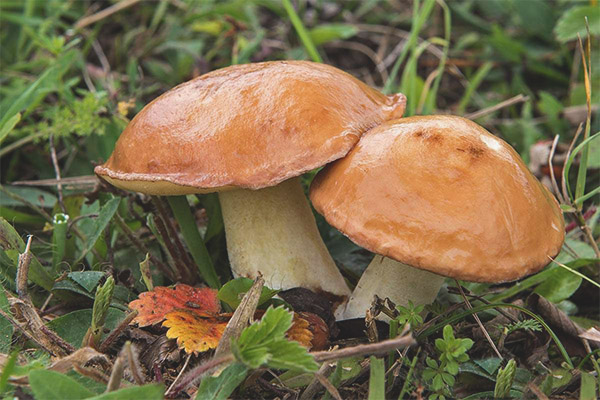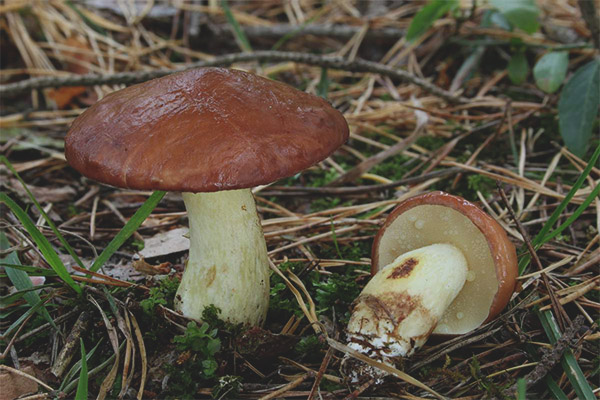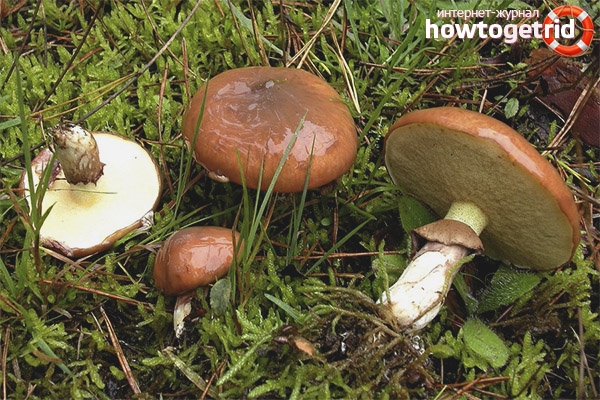The content of the article
The discussed variety of mushrooms is called a butter dish due to the characteristic slippery cap. If we consider the fungus in detail, it may seem that its skin is oiled. It glitters and shimmers. In various countries of the world, this variety is as they do not call it: masliuk, oil cooler, oil butter, etc. Today's material is devoted to this variety. We will consider it in detail.
Description
- The leg does not grow more than 10 cm in height according to the cylinder format. The averages stay within 5–8 cm. The base is 3-4 cm in diameter. It is colored with a whitish tinge, the lower part is darker, the tone coincides with the top. There are frequent cases when a white liquid comes out of a leg. It freezes, the mushroom looks granulated.
- Maslata belong to the middle representatives of the mushroom family. They are somewhat similar to the mokhovikami.The hat on the format of the hemisphere after ripening mushrooms becomes smooth. According to its external data reminds a pillow. The diameter grows to 15 cm. The final shade of the fungus depends on the growing area and the variety of a particular specimen.
- A distinctive feature is that there is a skin-film on the cap, it glitters and sticks. When it is damp outside, the hat becomes slippery. If the mushrooms grow dry, the hat will crack or become velvety. The peel is easily separated from the cap. The color of the hat varies, it may be ocher, brownish, brown, yellow, chocolate. Spots or color transitions may occur.
- The soft part is compacted, soft, pigmented by yellow or white. If you cut it or break it, then red or blue pigment will appear. The smell of pulp is absent, but sometimes the mushroom can smell like needles. Butters are suitable for food only in the first week of maturation, because they age quickly. After 8 days, the peel sags and darkens, the fruiting bodies begin to rot and wrinkle.
- Not all have oil, but a larger number of them have a veil. It is located under the hat, connecting it with the base.When a copy is ripening, its cover is torn. A ring is formed on the stalk. As far as reproduction is concerned, it is carried out by spores in color yellow or so.
Sprouting
- Representatives of the species are common in Asian and European countries. They are found in the Northern Hemisphere. However, there are colonies growing in Australia and Africa. Maslata prefer to dwell under the needles, but are often found in an oak grove or near birch trees.
- It all depends on the specific colony. The first group can grow with only one species of trees. The second lives with different varieties, including cedar, spruce, pine, deciduous species. These mushrooms almost do not grow in a dark forest.
- If a quick, quiet hunt is planned, then it is necessary to set off for deforestation, forest edges, forest trails and roadsides, as well as various glades and thickets of young needles. Maslata grow singly and colonially.
- These representatives of the species appear rather early, therefore in June-July you can be engaged in gathering. It lasts until October, but it all depends on the growing area.In some climatic zones, these mushrooms are sent as early as April.
- If you follow the national signs, then the first batch of mushrooms boletus coincides with the beginning of flowering of pines. And the second harvest makes itself felt as soon as linden begins to bloom in July. The third approach is not connected with anything, just for the mushrooms all the conditions of comfortable existence are created. They need to go in the middle or late fall. Because at this time the temperature usually keeps above 15 degrees.
- These mushrooms grow poorly at low temperatures. They need warmth as well as sufficient moisture. After the rain, the first specimens appear on the surface after two days. If the soil freezes in the autumn, the mushrooms will stop growing.
Varieties of butter dish
Now we will study what types of these mushrooms exist, how they differ from each other and how they look. It will be exclusively about edible species.
- This variety is edible; it occurs quite early in the summer season. Growth is carried out by colonies, so collecting a basket is not difficult. The hat grows in diameter to 5-9 cm, the format changes as it grows up, as does the color. Young stock is famous for a convex cap, it is pigmented red.In older specimens, the tip resembles a pillow, colored orange-yellow.
- The surface of the hat is shiny, dry and lint-free. However, when it is damp outside, the peel becomes covered with mucus and becomes slippery. Separate the skin is not difficult. The base has a brownish, brown or light yellow color. The length of the leg grows up to 8 cm. With a diameter of 1.5 cm. Maximum. Cylinder format
- From pores oozing fluid, which is usually located in the upper part of the base. It dries out, after which the mushroom itself looks spotty and uneven. There are no rings on the base, the tubes grow to the stem, and they are pigmented with a yellow or yellow-brown color.
- The soft part is painted in a light beige color. Smells good, to taste gives a nut. If you cut the mushroom, in this area it will darken. Reproduction is carried out by spores, the powder has a brown-yellow color. Maslata grow under a pine or spruce. You can meet them in the thickets, starting in June, ending November.
White
- Otherwise, this variety is called pale or soft. Growing in groups, you need to look exactly the same as the previous grade. In the period from the beginning of the summer to the middle or beginning of November.White representatives settle under cedar or pine. The hat is modified, it all depends on age. It first bulges, then becomes flat or acquires a funnel format.
- The tip in size is about 10 cm. The skin on it is slippery, smooth, pigmented with a yellowish tinge. A purple glow may appear periodically. Tubes are painted dark. Leg on the cylinder format, grows up to 7 cm. Maximum. It is colored yellow or white, specks of brown color can be observed. The ring is missing.
- If you remove the skin, the soft part will be pigmented with a purple hue. In the middle, it will turn yellow or turn white. Taste and smell are practically absent. When gathering preference is given to the young, because the old specimens rot and become wormy.
Motley
- In another way, this species is called brown-yellow butter dish, motley, swamp moth, swamp, sandy flyworm. The cap grows in diameter up to 13 cm. In young stock it has a hemisphere, and in adult specimens it is fleshy, like a pillow.In color, the tip is olive, brown-yellow, reddish or orange. Skin clean off difficult.
- If you compare this member of the family with yourself, the distinguishing characteristic is the absence of mucus on the hat. There are small villi there. The length of the base is 4-9 cm., The format of a cylinder or a pin, diameter - 2 cm.
- The soft part takes on a bluish tint on the cut. The tubes are painted olive. The mushroom smells like metal or pine needles. These mushrooms grow in small colonies, so the harvest will have to work.
Ordinary
- Such fruit bodies also bear the second name. Most often, the mushrooms are called real, late, autumn or yellow. In such instances, the cap has a convex shape, and the color may be brown-chocolate, red-brown, brown-purple or yellow-brown. Also present mucous peel.
- When processing it is quite easy to shoot. The diameter of the cap can reach up to 13 cm. You can also see that the tubes are attached to the leg. They have a pleasant yellowish tint. Spores are colored brown. The foot of the fruit in height can be up to 10 cm, and its diameter is up to 3 cm.
Red-red
- In such fruit bodies, one can observe a fleshy cap. Her diameter can reach up to 15 cm. They have a semicircular shape. Over time, the cap becomes cushion. It is colored yellow-orange. In this case, you can observe a fibrous structure with reddish scales.
- Along the edges of the cap are visible remnants of a white blanket. That it connects the leg and cap of young fruit bodies. When the cover is torn, a ring can be seen on the leg. Its height can reach 11 cm. The color is almost the same as that of the cap.
- The flesh has a dense structure. It is painted yellow. Moreover, if the flesh is notched, it will turn red. The tubular layer has an orange sheen. Spore powder painted in olive color. The bodies begin to bear fruit from mid-summer to mid-autumn on mountain slopes and in coniferous forests.
- Edible mushroom has a brown cap, whose diameter can reach up to 15 cm. It does not have a sticky surface. Rather, the surface is more matte. You can even say as if it is covered in wax. In this case, the hat may be yellow or brownish.
- Often the flesh is colored yellowish. If you cut it, you can see a bluish color. It tastes slightly sour. Tubes are often painted from olive to brown. You can also see an interesting picture of how the pores of the fungus secrete whitish juice.
- After drying, it becomes brown in color. The leg of the fruit under consideration has a thickness of up to 3 cm, and a height of up to 12 cm. At the same time, it tapers closer to the cap. The surface of the stem of such mushrooms may have reddish patches.
Siberian
- The presented fruit bodies belong to edible mushrooms, but only the lowest category. At the same time, their sizes are average. The cap may have a maximum diameter of 10 cm. In young specimens it is spherical in shape. Over time, it straightens.
- At young fruits the hat is painted in straw color. With age, it begins to darken. Red-brown spots appear. Peel these mushrooms with mucus. Especially after the rain. However, it is very easy to remove.
- Young fruit bodies have a veil, with time it breaks. As a result, there is a ring on the leg. Yellow tubules eventually acquire a brownish color. Sometimes a small amount of fluid is released.Which, after drying darkens.
- The leg of such fruits grows up to 9 cm. Thickness can be about 3 cm. Most of these mushrooms are found in Siberia and North America. They are rarely found in Europe. Often the fruits grow in coniferous forests. Such mushrooms are quite rare.
Notable
- The cap has a rather large size up to 15 cm and a dense, fleshy flesh. Leg relatively short. On the surface of the cap there is sticky mucus and scales. When processing, remove the skin does not make any problems.
- Leg length ranges from 4 to 11 cm. Thickness does not exceed 2 cm. Also there is a ring on it. The leg is painted in a whitish-yellow shade. The flesh is yellow, and when cut, it turns pinkish. After that, it turns brown.
Benefit
- Fruit bodies have low calorie content, unforgettable taste and many useful qualities. 100 gr. raw materials account for only 20 Kcal. They contain B vitamins, retinol, ascorbic and nicotinic acid.
- Also, the pulp of mushrooms is saturated with zinc, potassium, manganese, phosphorus and iron.Maslata act as a natural antibiotic, aphrodisiac and immunostimulant.
- Also, the systematic consumption of fruit bodies helps to eliminate a strong migraine. Mushrooms are successfully used in the treatment of the musculoskeletal system, nervous system and heart.
Contraindications
- If you prepare fruit bodies incorrectly, then you may encounter problems of a certain nature. Remember that you need to collect copies in environmentally friendly places. Otherwise, you can earn poisoning.
- The spongy structure of fungi easily absorbs all the harmful compounds that are present in the soil and the environment. Mushrooms are capable of accumulating heavy metals. Especially it is necessary to be afraid of old mushrooms with big hats.
- In no case do not collect and do not eat wormy specimens. Worms can cause severe poisoning and an allergic reaction in a person.
- Always get rid of the film on the mushrooms that is present on the caps before cooking. The problem is that even with heat treatment, it often provokes diarrhea.Of particular danger are canned mushrooms with the presence of such a film. In addition, the specimens must be thoroughly washed.
In this material we looked at healthy and delicious mushrooms, in which there are many edible varieties. Remember that it is necessary to engage in gathering, given the place of growth and climatic conditions. Most of the specimens appear in the summer, fructification is carried out until the fall. Mushrooms do not like dark forests, so you need to look for them in bright areas.
Video: butter dish (Suillus)














To send